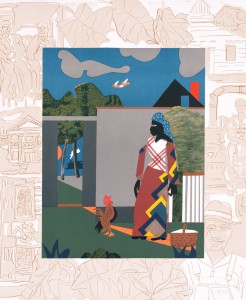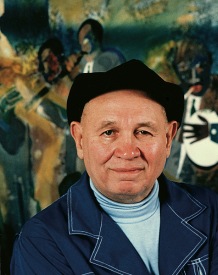 I mentioned the other day that Mrs. T and I were thinking about adding a new piece to the Teachout Museum. After long and careful consideration, we decided to take the plunge and place a bid, and we are now the proud owners of a signed copy of “Pepper Jelly Lady,” a 1980 lithograph by Romare Bearden that is also part of the collection of the Smithsonian American Art Museum.
I mentioned the other day that Mrs. T and I were thinking about adding a new piece to the Teachout Museum. After long and careful consideration, we decided to take the plunge and place a bid, and we are now the proud owners of a signed copy of “Pepper Jelly Lady,” a 1980 lithograph by Romare Bearden that is also part of the collection of the Smithsonian American Art Museum.
Based on one of Bearden’s boldly colored cubist collages, “Pepper Jelly Lady” shows a West Indian woman selling homemade jelly in front of a walled estate. It was originally part of a portfolio of six prints by Bearden, Ansel Adams, Audrey Flack, Sam Francis, Robert Indiana, and Wayne Thiebaud that were created by the artists to be sold by the Democratic Committee Service Corporation to raise funds for Jimmy Carter’s 1980 presidential campaign. This particular lithograph exemplifies the Louis Armstrong-like optimism of Bearden’s work, in which the black experience in America is portrayed honestly but hopefully. “Even though you go through these terrible experiences, you come out feeling good,” he once said. “That’s what the blues say and that’s what I believe—life will prevail. That’s why I’ve gone back to the South and to jazz.”
 One of Bearden’s most admired prints, “Pepper Jelly Lady” was chosen for inclusion in “A Graphic Odyssey: Romare Bearden as Printmaker,” a large-scale traveling exhibit of more than one hundred lithographs, monoprints, collagraphs, screenprints, and etchings that toured the United States in 1994 and 1995. Holland Cotter reviewed “A Graphic Odyssey” for The New York Times, and “Pepper Jelly Lady” figured in his review:
One of Bearden’s most admired prints, “Pepper Jelly Lady” was chosen for inclusion in “A Graphic Odyssey: Romare Bearden as Printmaker,” a large-scale traveling exhibit of more than one hundred lithographs, monoprints, collagraphs, screenprints, and etchings that toured the United States in 1994 and 1995. Holland Cotter reviewed “A Graphic Odyssey” for The New York Times, and “Pepper Jelly Lady” figured in his review:
The show opens with prints based on Bearden’s childhood. In “Quilting Time”—whose composition Bearden used in a painting, a mosaic and a lithograph—two women bend over their sewing in a small house as a pink sunset sky glows outside the window. In “Pepper Jelly Lady” a figure in a dashingly patterned dress is framed by a wide border filled with drawings of Southern life: a plain wooden church, a porticoed mansion, a room with a potbellied stove….
Bearden considered himself an essentially American artist, and relished the ingredients in his own life that defined that odd collage of an identity: North Carolina and Paris; Melville and Billie Holiday; Buddhism and the Bible; Matisse and African masks. Although rarely a polemicist, he was alert to political realities. Artistically a traditionalist, his daring was to combine a wide range of traditions: traces of European, African, Asian and American cultures mingle in his prints like a rich perfume.
Mrs. T and I are delighted to be able to hang on our walls so beautiful a work by one of America’s greatest artists.


